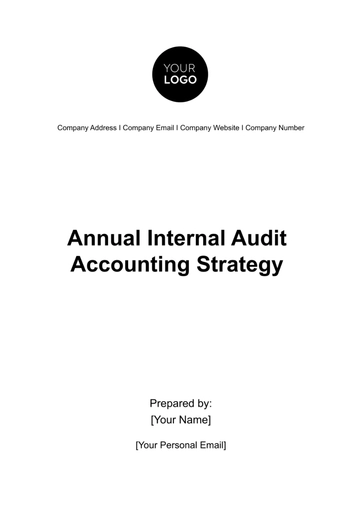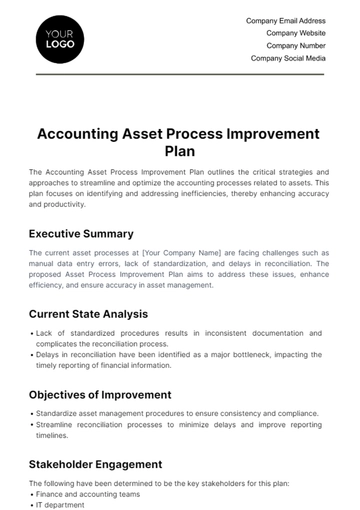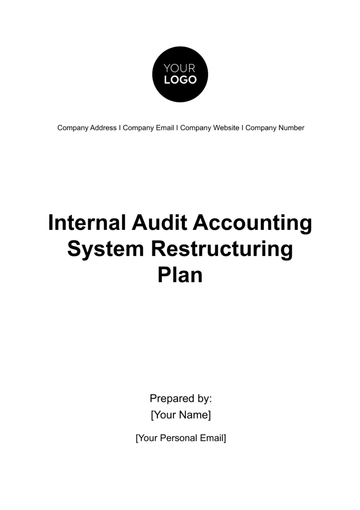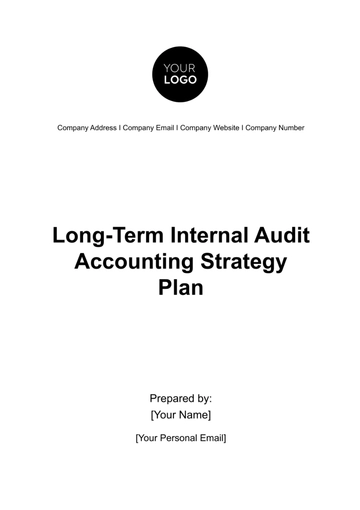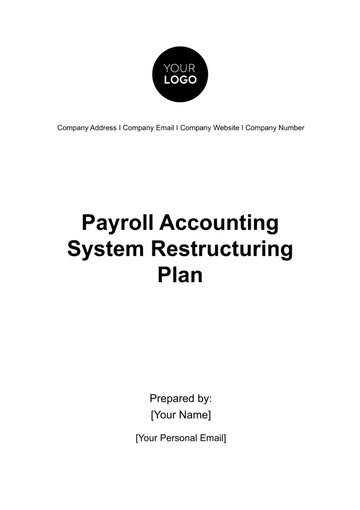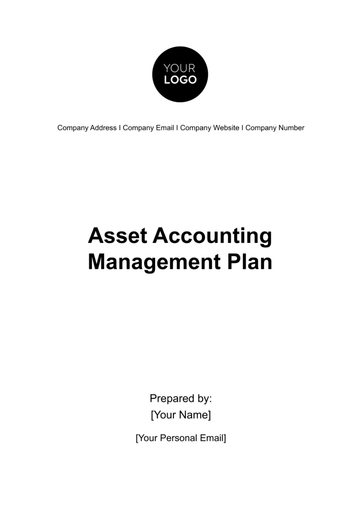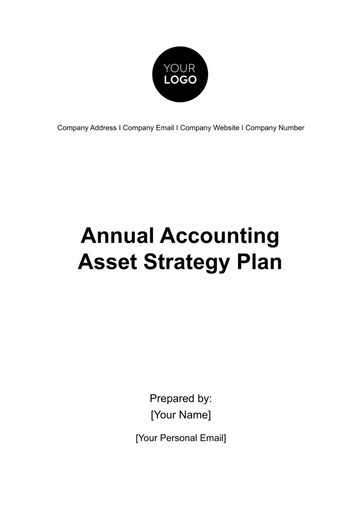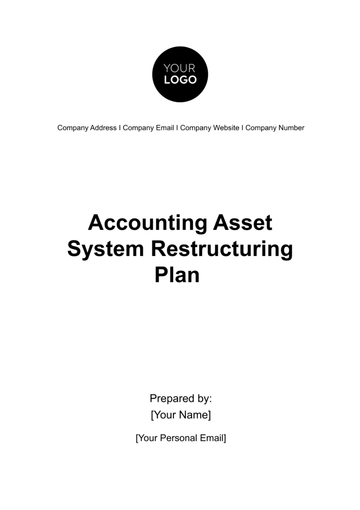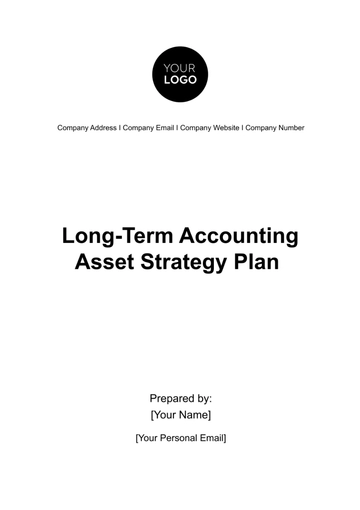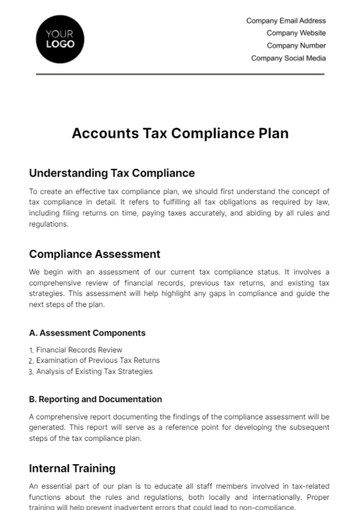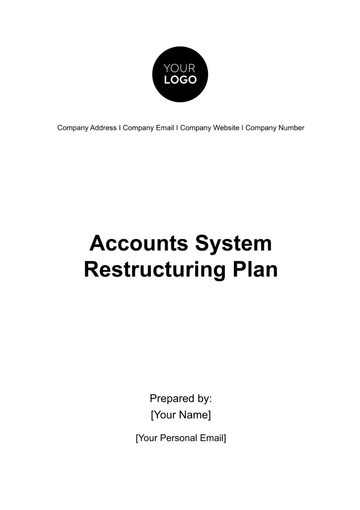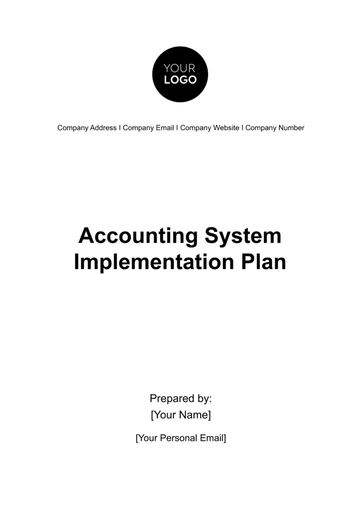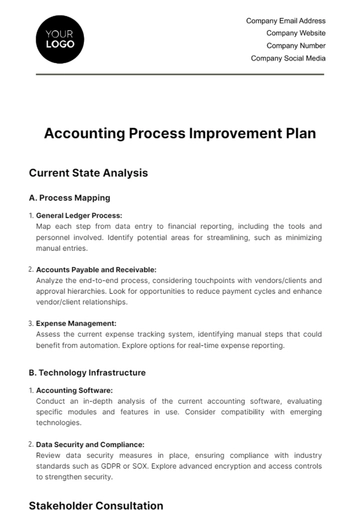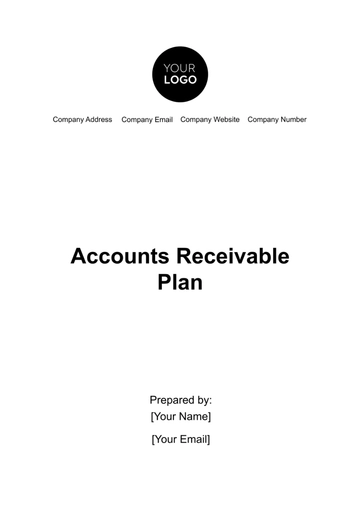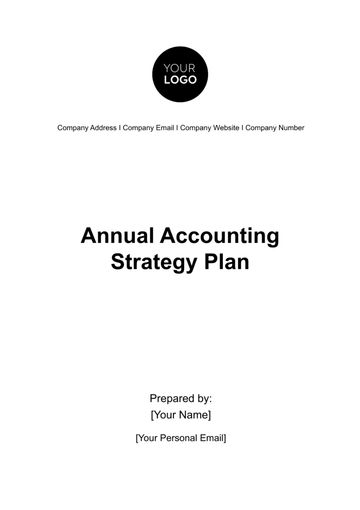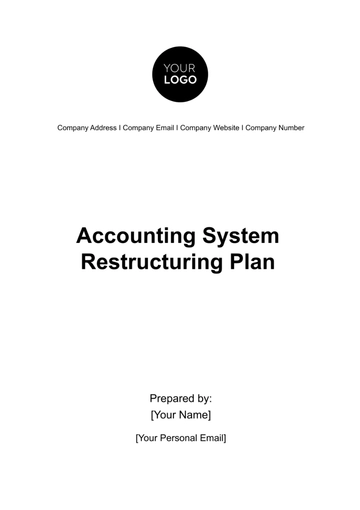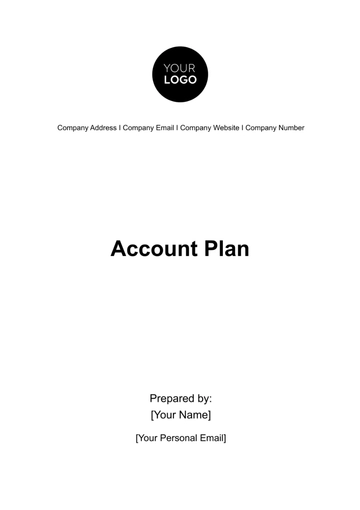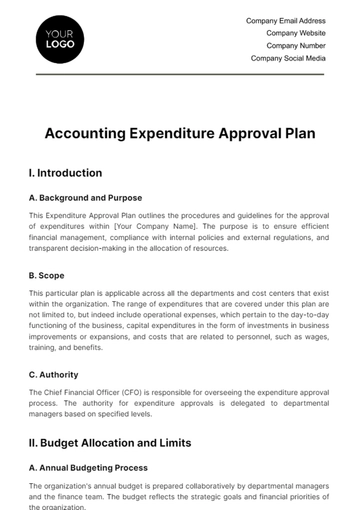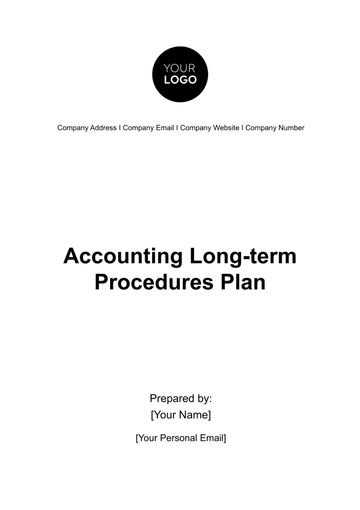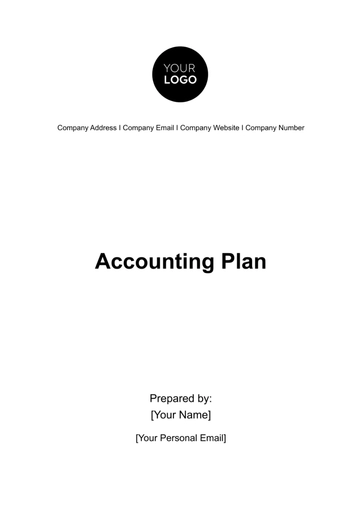Free Annual Payroll Accounting Strategy Plan
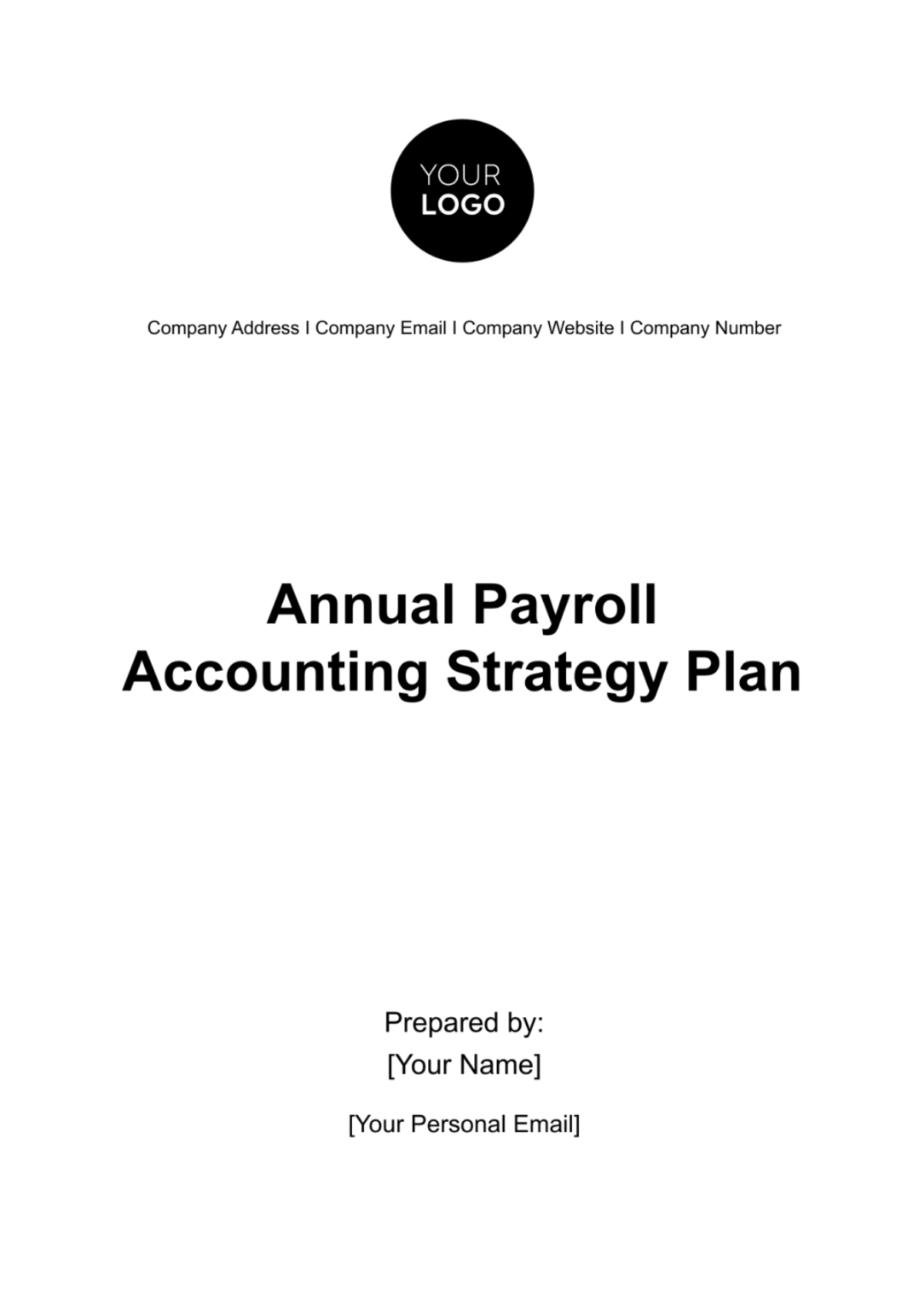
Executive Summary
In this comprehensive Annual Payroll Accounting Strategy Plan, [Your Company Name] aims to fortify its financial foundations by addressing critical aspects of payroll management. Recognizing the pivotal role of precise payroll accounting, this plan outlines strategic objectives, key performance indicators, and detailed action plans.
In the pursuit of excellence, our primary focus areas include ensuring regulatory compliance, minimizing errors, optimizing efficiency, and strategically reducing costs.
Introduction
A. Background
As of 2050, [Your Company Name] oversees payroll operations for [1,120] employees distributed across various departments. While maintaining a steady payroll, we have identified areas for improvement, such as occasional errors leading to financial discrepancies and an opportunity to streamline costs associated with payroll processing.
B. Purpose
The purpose of this plan is two-fold. Firstly, it aims to establish a robust framework that guarantees precision in payroll accounting, meeting and exceeding all regulatory requirements. Secondly, it sets out to optimize operational efficiency, strategically reducing costs associated with payroll processing. This plan is designed not only to address current challenges but also to position [Your Company Name] for future success in financial management.
Objectives
A. Accuracy and Compliance
Our primary goal is to achieve [99.5%] accuracy in payroll processing, meeting all relevant regulatory requirements. The current error rate stands at [1.2%], leading to an annual financial discrepancy of [$10,000]. To achieve this objective, we will implement rigorous validation checks, conduct regular training for payroll staff, and leverage advanced payroll software features for automated compliance updates.
B. Efficiency and Cost Reduction
To enhance operational efficiency, we target a [15%] reduction in overall payroll processing costs. The current annual cost is [$350,000], and this reduction will result in an estimated savings of [$52,500] annually. Strategies include process automation, vendor negotiation for software licensing, and optimizing resource allocation within the payroll department.
Data Management and Security
A. Data Collection
Employee data collection will be facilitated through an HR System, ensuring accuracy in personal details, tax information, and hours worked. As of [2055], the data collection process is prone to a [2%] error rate. To mitigate this, we will implement a dual-verification system and conduct regular audits. The goal is to reduce the error rate to below [1%].
B. Security Measures
To safeguard sensitive payroll data, we employ robust security measures. Encryption protocols will be enforced for data transmission, and access controls will restrict data access to authorized personnel. Regular security audits, conducted annually, will ensure compliance with data protection standards.
Data Security Measure | Implementation Details |
|---|---|
Encryption Protocols | All data transmissions will use industry-standard encryption |
Technology Integration
A. Payroll Software
[Your Company Name] utilizes [Payroll Software X], offering features such as automated tax calculations and real-time reporting. The current software license costs [$20,000] annually. To optimize costs, we will negotiate with the software provider for a [10%] reduction in licensing fees during the upcoming contract renewal.
B. Integration with HR Systems
Our payroll system seamlessly integrates with [Your HR System], minimizing manual data entry errors. This integration is expected to reduce processing time by 20%. Regular updates and training programs will ensure that the payroll team maximizes the benefits of this integrated approach.
Payroll Software Features | Benefits |
|---|---|
Automated Tax Calculations | Minimizes errors in tax deductions |
By leveraging advanced technology and ensuring seamless integration, [Your Company Name] aims to create a more resilient and efficient payroll management system.
Payroll Processing Timeline
Our payroll processing timeline is designed to ensure efficiency and accuracy throughout the entire payroll cycle. The following table outlines the key stages and their respective durations.
Process Stage | Duration |
|---|---|
Data Collection | 1st to 5th of the month |
This timeline allows for a systematic approach, ensuring that each stage is completed thoroughly and on time. Timely disbursement on the 16th of the month provides financial clarity for employees and promotes overall satisfaction.
Metrics and Key Performance Indicators (KPIs)
A. Error Rate
The current error rate in payroll processing is [1.2%]. The target is to reduce this to below [1%]. Continuous monitoring and feedback mechanisms, coupled with enhanced data verification processes, are expected to contribute to achieving this goal.
B. Processing Time
Currently, the payroll processing time is [10] days. The target is to reduce this to [7] days, improving overall efficiency. Process automation, streamlined workflows, and employee training programs will play key roles in achieving this reduction.
Key Performance Indicator | Current Value | Target Value |
|---|---|---|
Error Rate | [1.2%] | [<1%] |
These KPIs will be regularly monitored, and corrective actions will be implemented promptly to ensure the continual improvement of our payroll processes.
Training and Development
To enhance the proficiency of our payroll team and ensure compliance with evolving regulations, a comprehensive training program will be implemented.
A. Training Focus Areas:
Regulatory Updates: Bi-annual training sessions on tax code changes and payroll compliance updates.
Software Proficiency: Monthly sessions to maximize the utilization of [Payroll Software X].
Error Prevention: Quarterly workshops focusing on error identification, prevention, and correction.
The training budget for the year is [$15,000], allocating resources for external trainers, online courses, and training materials.
Continuous Improvement
A. Feedback Mechanisms
Establishing regular feedback mechanisms is crucial for identifying areas of improvement. Anonymous surveys will be conducted quarterly among payroll staff to gather insights on process efficiency and identify any challenges they may be facing. Feedback will be reviewed, and necessary adjustments will be made.
B. Regular Audits
Annual audits, both internal and external, will be conducted to assess the effectiveness of our payroll processes. These audits will include a comprehensive review of compliance measures, data security protocols, and overall accuracy. Identified issues will be addressed promptly to ensure ongoing improvement.
Additionally, quarterly performance reviews will be conducted to assess the progress of the Annual Payroll Accounting Strategy Plan against set objectives. Adjustments to strategies and tactics will be made based on the outcomes of these reviews, allowing for agile responses to emerging challenges.
Budget and Resource Allocation
A transparent breakdown of the budget allocated for the implementation of the Annual Payroll Accounting Strategy Plan is crucial for effective financial management.
Expense Category | Budget Allocation |
|---|---|
Training Programs | [$15,000] |
This budget aligns with our strategic goals and ensures that resources are allocated efficiently to support the successful execution of the plan.
Communication Plan
Effective communication is key to the seamless implementation of the Annual Payroll Accounting Strategy Plan. The communication plan outlines channels and strategies for disseminating information to internal and external stakeholders.
A. Internal Communication
Regular team meetings led by [Your Name], Payroll Manager, to discuss updates, challenges, and successes.
Monthly newsletters to keep all employees informed about changes in payroll processes and upcoming training sessions.
B. External Communication
Quarterly updates to [Your Partner Company Name], Payroll Software Provider, regarding system performance and feedback.
Announcements on [Your Company Social Media] platforms to inform clients and followers about improvements in payroll processing.
Risk Management
Identifying and mitigating potential risks is integral to the success of our Annual Payroll Accounting Strategy Plan. A comprehensive risk management approach involves anticipating challenges and implementing proactive measures.
A. Potential Risks
Data Breach: The risk of unauthorized access to sensitive payroll data.
Regulatory Changes: Changes in tax codes or labor laws impacting payroll compliance.
Software Downtime: Unforeseen technical issues leading to disruptions in payroll processing.
B. Mitigation Strategies
Data Encryption: Implement and maintain robust data encryption protocols.
Regular Compliance Audits: Conduct quarterly reviews to ensure compliance with evolving regulations.
Backup Systems: Implement backup systems to minimize downtime in case of software issues.
By addressing these potential risks, we aim to build resilience into our payroll processes and ensure the continued accuracy and security of payroll data.
Conclusion
The Annual Payroll Accounting Strategy Plan outlined above reflects [Your Company Name]'s commitment to precision, compliance, and efficiency in payroll management. With specific objectives, measurable KPIs, and a well-defined implementation roadmap, we are poised to enhance our payroll processes and contribute to the overall financial health of the organization.
This plan will be regularly reviewed and adjusted as needed to adapt to changing circumstances and ensure continual improvement. We appreciate the dedication of our payroll team and the collaboration of our stakeholders in achieving these strategic objectives.
- 100% Customizable, free editor
- Access 1 Million+ Templates, photo’s & graphics
- Download or share as a template
- Click and replace photos, graphics, text, backgrounds
- Resize, crop, AI write & more
- Access advanced editor
Elevate your payroll strategy with the Annual Payroll Accounting Strategy Plan Template from Template.net. This editable and customizable tool empowers you to craft a comprehensive strategy for efficient payroll management. Use our Ai Editor Tool to tailor it to your unique needs, ensuring your annual payroll processes are seamless and optimized. Stay ahead with this powerful resource for strategic payroll planning.
You may also like
- Finance Plan
- Construction Plan
- Sales Plan
- Development Plan
- Career Plan
- Budget Plan
- HR Plan
- Education Plan
- Transition Plan
- Work Plan
- Training Plan
- Communication Plan
- Operation Plan
- Health And Safety Plan
- Strategy Plan
- Professional Development Plan
- Advertising Plan
- Risk Management Plan
- Restaurant Plan
- School Plan
- Nursing Home Patient Care Plan
- Nursing Care Plan
- Plan Event
- Startup Plan
- Social Media Plan
- Staffing Plan
- Annual Plan
- Content Plan
- Payment Plan
- Implementation Plan
- Hotel Plan
- Workout Plan
- Accounting Plan
- Campaign Plan
- Essay Plan
- 30 60 90 Day Plan
- Research Plan
- Recruitment Plan
- 90 Day Plan
- Quarterly Plan
- Emergency Plan
- 5 Year Plan
- Gym Plan
- Personal Plan
- IT and Software Plan
- Treatment Plan
- Real Estate Plan
- Law Firm Plan
- Healthcare Plan
- Improvement Plan
- Media Plan
- 5 Year Business Plan
- Learning Plan
- Marketing Campaign Plan
- Travel Agency Plan
- Cleaning Services Plan
- Interior Design Plan
- Performance Plan
- PR Plan
- Birth Plan
- Life Plan
- SEO Plan
- Disaster Recovery Plan
- Continuity Plan
- Launch Plan
- Legal Plan
- Behavior Plan
- Performance Improvement Plan
- Salon Plan
- Security Plan
- Security Management Plan
- Employee Development Plan
- Quality Plan
- Service Improvement Plan
- Growth Plan
- Incident Response Plan
- Basketball Plan
- Emergency Action Plan
- Product Launch Plan
- Spa Plan
- Employee Training Plan
- Data Analysis Plan
- Employee Action Plan
- Territory Plan
- Audit Plan
- Classroom Plan
- Activity Plan
- Parenting Plan
- Care Plan
- Project Execution Plan
- Exercise Plan
- Internship Plan
- Software Development Plan
- Continuous Improvement Plan
- Leave Plan
- 90 Day Sales Plan
- Advertising Agency Plan
- Employee Transition Plan
- Smart Action Plan
- Workplace Safety Plan
- Behavior Change Plan
- Contingency Plan
- Continuity of Operations Plan
- Health Plan
- Quality Control Plan
- Self Plan
- Sports Development Plan
- Change Management Plan
- Ecommerce Plan
- Personal Financial Plan
- Process Improvement Plan
- 30-60-90 Day Sales Plan
- Crisis Management Plan
- Engagement Plan
- Execution Plan
- Pandemic Plan
- Quality Assurance Plan
- Service Continuity Plan
- Agile Project Plan
- Fundraising Plan
- Job Transition Plan
- Asset Maintenance Plan
- Maintenance Plan
- Software Test Plan
- Staff Training and Development Plan
- 3 Year Plan
- Brand Activation Plan
- Release Plan
- Resource Plan
- Risk Mitigation Plan
- Teacher Plan
- 30 60 90 Day Plan for New Manager
- Food Safety Plan
- Food Truck Plan
- Hiring Plan
- Quality Management Plan
- Wellness Plan
- Behavior Intervention Plan
- Bonus Plan
- Investment Plan
- Maternity Leave Plan
- Pandemic Response Plan
- Succession Planning
- Coaching Plan
- Configuration Management Plan
- Remote Work Plan
- Self Care Plan
- Teaching Plan
- 100-Day Plan
- HACCP Plan
- Student Plan
- Sustainability Plan
- 30 60 90 Day Plan for Interview
- Access Plan
- Site Specific Safety Plan


